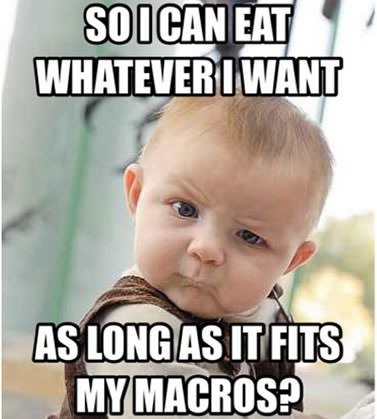What is Flexible Dieting?
Flexible Dieting (Or commonly known as If It Fits Your Macros) is simply the tracking of macronutrients (protein, carbohydrate and fat) to achieve a body composition goal.
Macronutrients or Macros make up the majority of our diets. There are three main macros: Protein, Fat and Carbohydrate. One gram of each macro has a calorie value.
- 1 Gram of Protein = 4 Calories
- 1 Gram of Carbohydrate = 4 Calories
- 1 Gram of Fat = 9 Calories
Rather than typical calorie counting (e.g. Eating 2000 cals a day) Flexible Dieters would track macronutrients (e.g. Eating 150g Protein, 80g Fat, 170g Carbohydrate = 2000 cals) which more effectively influences body composition rather than just weight loss or gain.
Please try out our mobile-optimized Macronutrient calculator here.
Flexible Dieting follows the belief that there are no miracle weight loss foods. No good or bad foods, just macro ratios.
For example:
McGrilled Chicken Burger:
- 25g Protein
- 33g Carbohydrate
- 15g Fat
OR
Brown Rice and Tuna
- 25g Protein
- 33g Carbohydrate
- 15g Fat
Both are the same macros and so both will achieve the same results in your body composition.
When food enters your stomach your body isn’t thinking “Healthy or unhealthy?” it is simply breaking down the food and processing the macronutrients.
Essentially, to change your body you can eat whatever you want so long as you hit your macro goals. This was demonstrated in the twinkie diet.
To maintain and improve overall health, although not necessary to change your body, I’d recommended tracking your fiber intake as well.This will ensure that you are getting enough micronutrients as well.
The American Heart Association recommends eating 14g of fiber per 1,000 calories consumed.

What Are the Benefits?
As I’ve mention before I’ve experimented with a wide range of different diets. All of them have their merits but Flexible Dieting is by far my favorite (And one I continue to follow today).
Below I’ll give three reasons why:
1. Effective
The most important tool in weight loss is understanding that a calorie deficit is necessary for losing weight.
Although quality is still important, quantity is the greater determining factor in weight loss or gain. If you’re not in a calorie deficit you can eat all the “good foods” you want and go nowhere.
By tracking everything that enters your mouth you stop the guess-work and take control over how & when you reach your goals. Tracking, whether it’s your macros or calories, is hands down the most effective way to change your body. (Read about how Jim lost 88 pounds by doing this)
2. Flexible (Duhhh)
Flexible dieting is just that: Flexible.
By focusing on your macronutrient intake rather than eating certain foods you can still achieve your goals while enjoying life with everyone else. You can have your cake and eat it too!
One of the challenges I’ve always found around dieting was the awkward social element. There’s only so many dinners you can bring tupperware containers full of rice and chicken to without feeling like a complete a-hole. Research shows that a more flexible approach leads to less anxiety, and more successful weight management.
By allowing yourself flexibility you can join in on meals with families and friends, so long as you keep track of what you’re eating.
3. Sustainable
For years my cycle would look the same. I’d set myself a super restrictive way of eating and then “Diet, Diet, Diet, Binge…Diet, Diet, Diet, Binge”.
I had such an unhealthy view of eating and because of that I never really stuck to anything long enough to get results.
I didn’t realize that food is not just physical it’s also psychological.
Flexible Dieting is the first thing that I’ve been stick to consistently over a long period of time. From my research and experience it seems to kill the “Diet, Binge” cycle many of us have found ourselves on.
Because you can eat whatever you want (in moderation) it’s more mentally & emotionally sustainable.
How to Get Started
1. Calculate your Macros
If you are a do-it-yourself kind of person and want to understand the process, then read the guide to setting your macros.
Or use our online macro calculator here.
2. Track Your Macros
This way of eating is all about tracking and measuring your macro intake.
I personally use My Fitness Pal as it has the worlds largest nutritional database. It’s also available across all platforms.
3. Buy a Food Scale
A lot of nutritional information is available on food packaging, however, a scale will ensure you accurately track what you eat.
Without overstating it I feel flexible dieting has completely revolutionized what and how I eat. I love having the ability to eat with family and friends, I’m seeing great results and I can see myself doing this for years to come.

